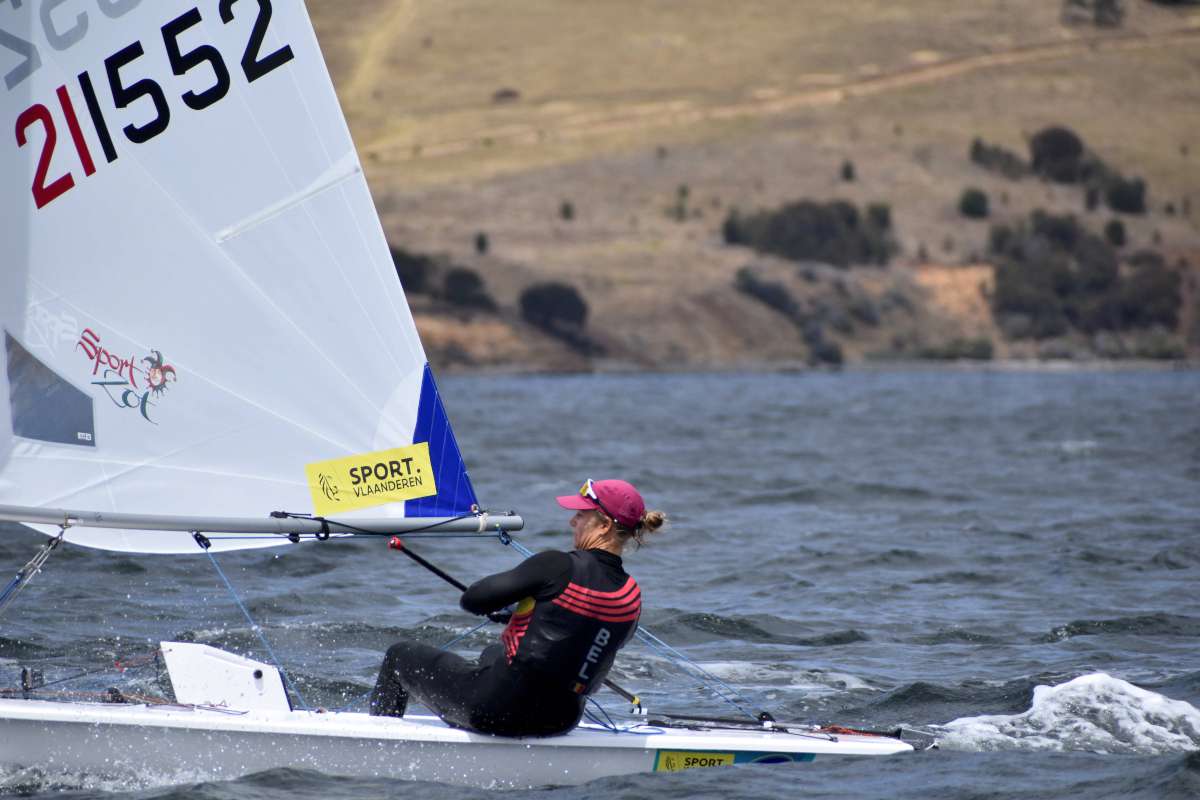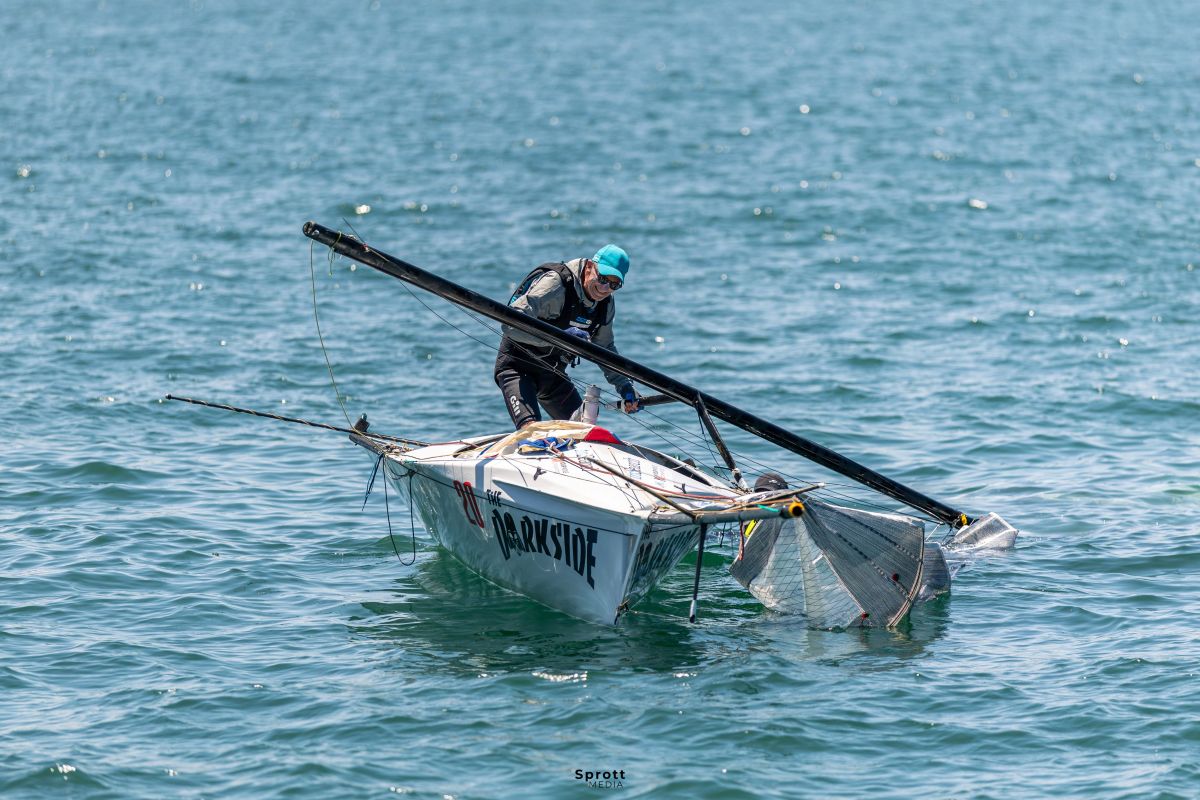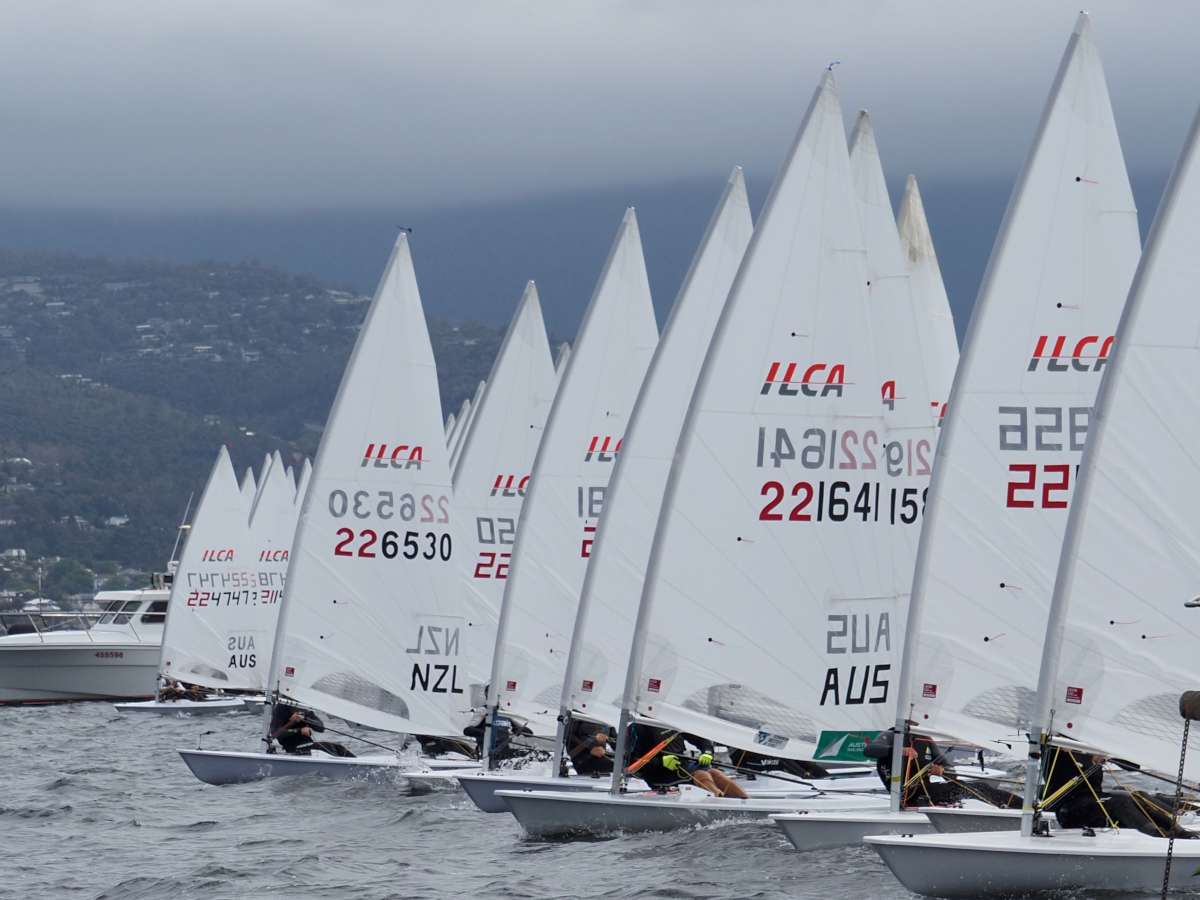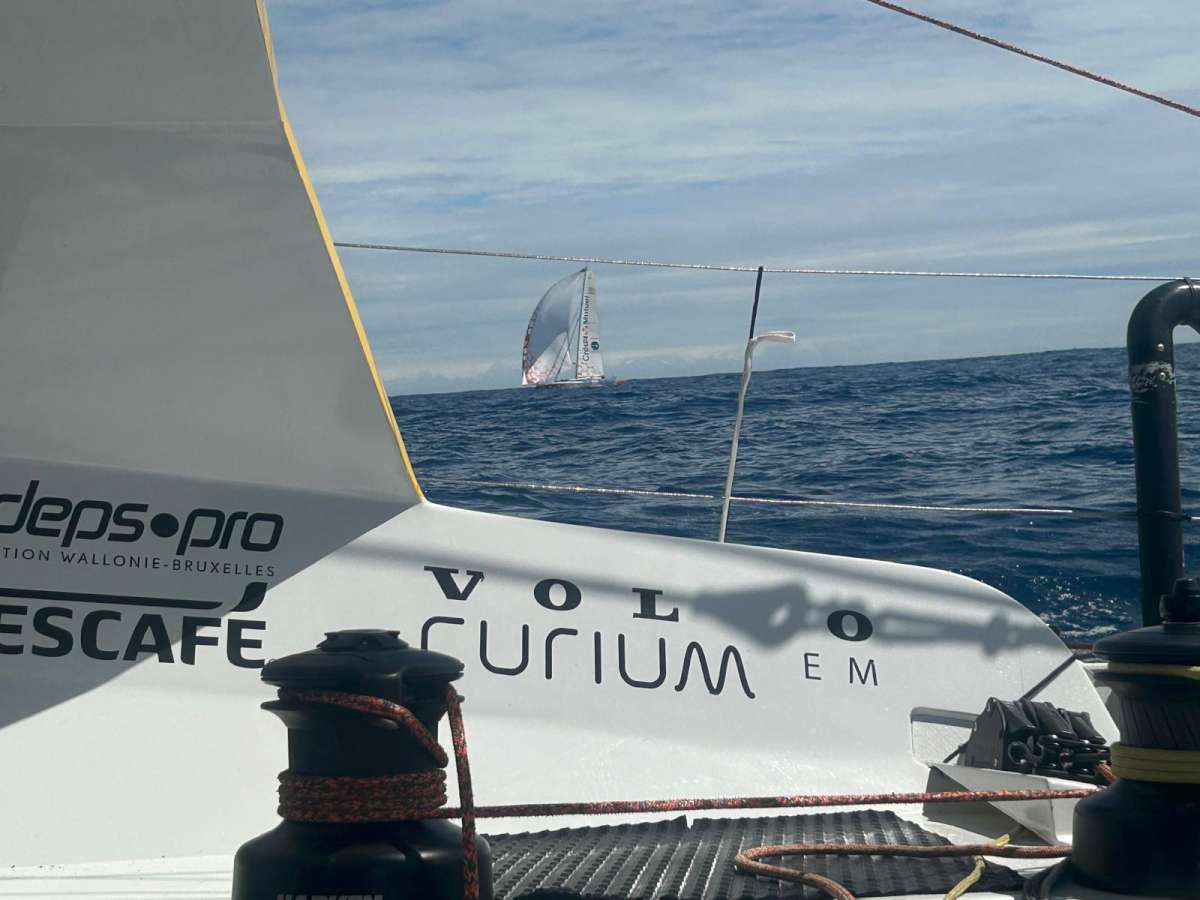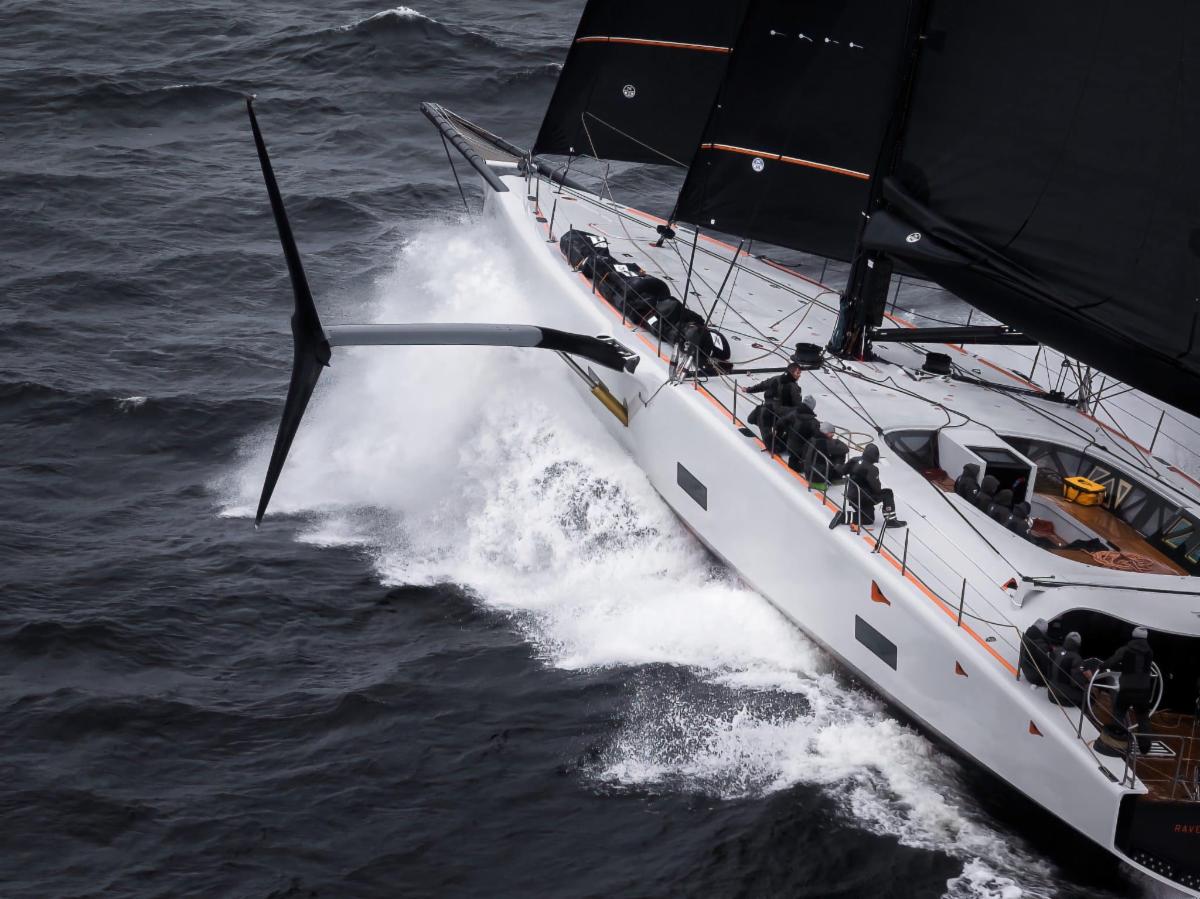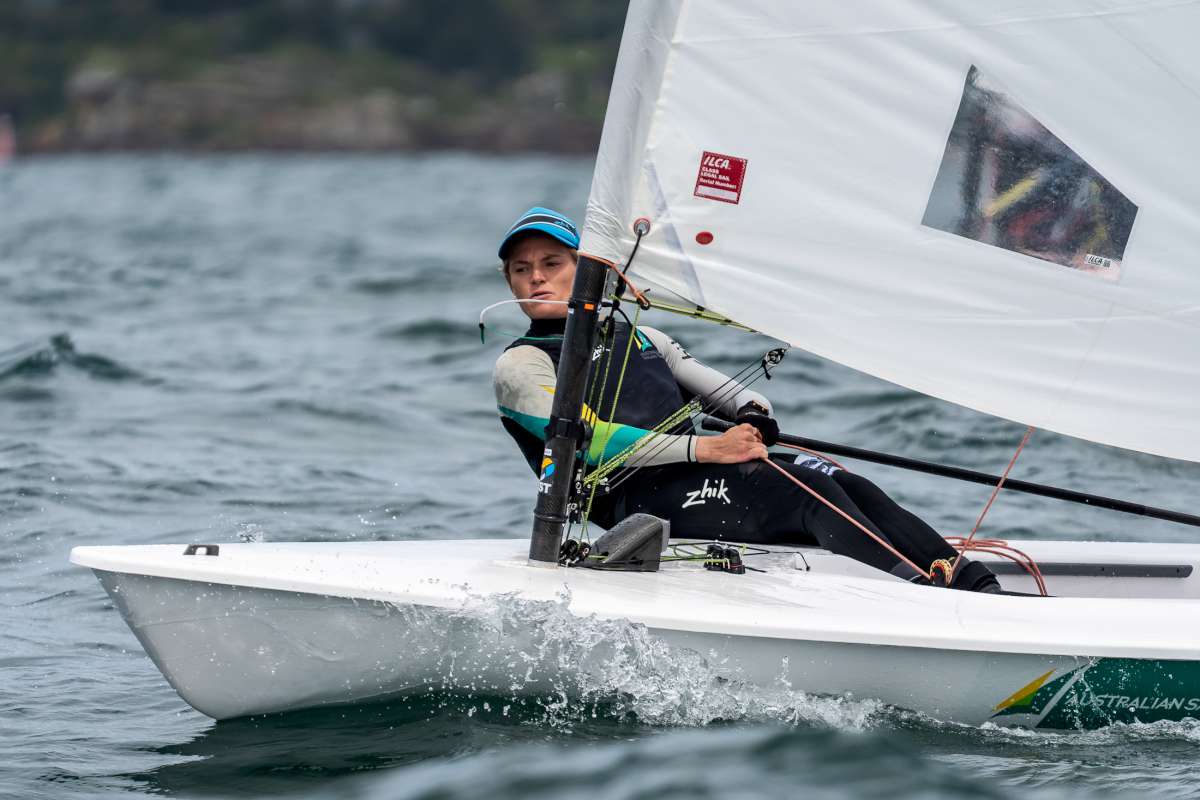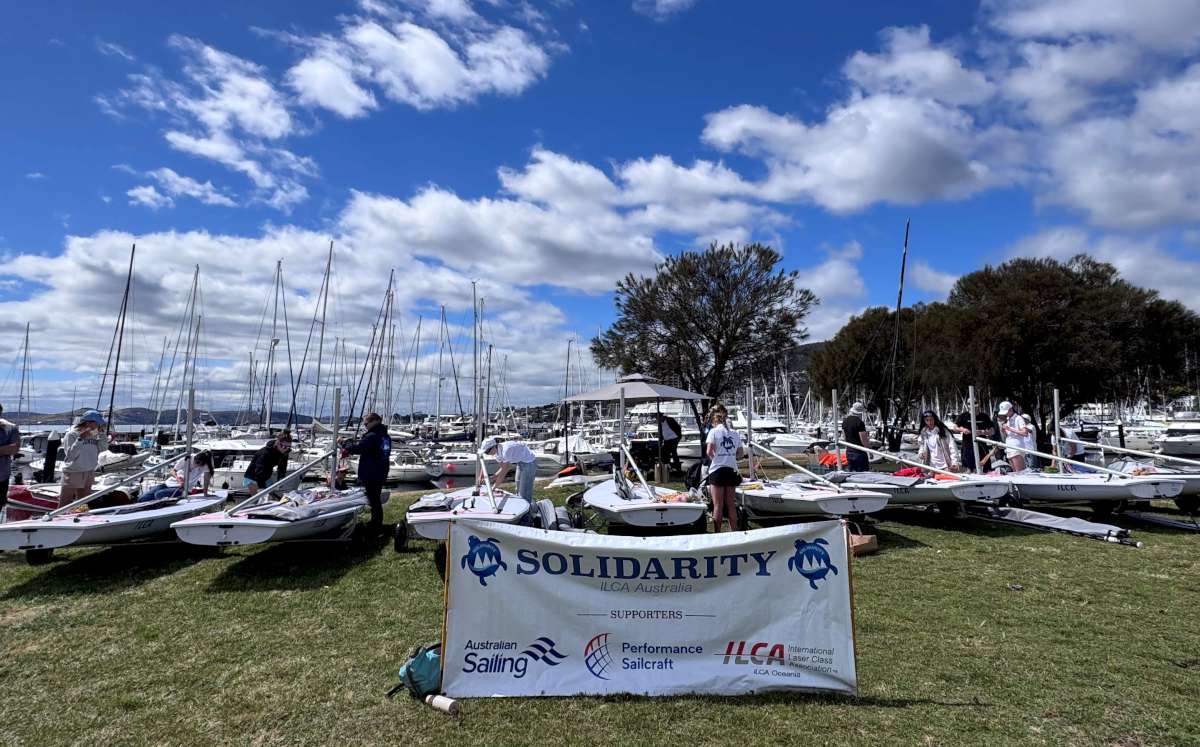This description is unapologetically multihull-centric, because that is what we sail. Sadly, we cannot afford to simultaneously own a monohull. There are installations on monohulls using the system described here, but the development work, plus this author’s experiences, are all on a catamaran. Our catamaran is 38 feet with a 22.5’ beam and draws 3.25’; weighing in at about seven ton in full cruising mode: water and fuel 600 kilograms, full food provisioning plus our crew of two.
To put this into a monohull comparison, our cat is equivalent in windage to a 45’ modern monohull, say a Bavaria 45, which might weigh 13t of which 6t will be ballast.
This bridle system, as described below, can be modified to use on a monohull where bridles are not common, but could and should be used more often.
Why bridle?
You should not rely on the chain on the windlass as the ultimate backstop should your snubber/bridle fail. There should be some way of isolating the windlass such that, if the tension transfers from the snubbers, the tension does not impact the windlass.
You need some form of chain stop; we have used a Dyneema strop attached to a strong point with a galvanised claw and, more recently, swapped to a stainless claw. But a conventional chain hook from a chandlery works well.
We use the same arrangement to secure the anchor and chain when on passage. You can buy chain locks, you can arrange to secure the chain using a bow cleat; there are usually lots of options as long as none of them rely on the windlass. A windlass is pretty indestructible, or most of them are, but it is the attachment to the deck that may not be quite so strong; plus the seals within the windlass do not enjoy being overstressed.
Bridles, as opposed to single line snubbers, help to share the load, but one arm may take most of the load at any one time. Because they can share the load they reduce the tension imposed on the securement point. Nylon, the cordage commonly used for snubbers and bridles, has a finite lifespan; part dictated by the historic amount of stress: the number of snatch or load cycles.
Sharing the load shares the snatch load and leads to a longer life for all affected parts. Sharing the load also helps centralise the yacht and reduces yawing. If you reduce yawing you reduce the snatch loads, where a snatch load on the yacht is a snatch load on the anchor: a genuine win/win. Yawing can be debilitating, reduce yawing and you will reduce irritability of crew. A further win/win!
Starting point
When we bought our catamaran, almost 20 years ago now, it came with what is in fact a fairly standard bit of kit: a bridle with two short arms, five metres each of a 20 millimetre three-ply. In our case it was secured to flanges welded to the ends of the forward crossbeam. The rope arms were well over strength and the system had minimal, elasticity.
We suspect the whole device was sufficiently strong to lift the whole yacht out of the water! But, at the time, we had plenty of other items that seemed more important so this incumbent bridle set-up remained.
One of our first priorities was finding a more reliable anchor. It is difficult to believe that 20 years ago the choice was Fortress and the poorly-marketed Spade, both introduced late ‘80s/early ‘90s; or the old stalwarts: CQR, Bruce or Delta. How things change.
Now we have Rocna, Ultra, Supreme, Excel, Spade, Fortress and Kobra. We have Lewmar’s LFX, a Fortress clone, plus a Vulcan, Mantus M1 and M2 and Knox. With Viking and Lewmar’s new steel iterations waiting in the wings for market release, we are, definitely spoilt for choice.
Who would have thought anchor making would be so popular, or is that profitable? It merits mention some anchors have appeared and sunk without trace: XYZ, Aqua-Bubble, Bulwagga, to name but a few.
Contemporaneous with anchor developments our 2x5m bridle seemed a simple bit of kit offering little room for improvement. How wrong we were.
Bridle developments
What a difference 20 years makes. Now our bridle arms are each 30m long with elasticity to break of over 40 per cent. They quell chop, subdue yawing and can absorb large snatch loads. In our case they do all this with a rode of lightweight, high tensile, 6mm chain while our primary anchor weighs 8kg, an aluminium alloy.
Surprisingly, bridles on new catamarans today are not much different to 20 years ago. The vessels have changed and improved, while the rode has been left in the dark ages.
Dashew pioneered the use of G70 chain on sailing yachts decades ago and provides it as standard on his expedition motor yachts. But the industry where it was developed i.e. sail yachts, has completely ignored the development. If anything, bridles have got worse, using even heavier duty cordage which has no elasticity at all.
Obviously, as we thought 20 years ago, most people think the same: ‘not much room for improvement’. We believe and hope to show, this is wrong!
We are not singling out multihulls for criticism, you will be lucky to be offered a snubber at all for any yacht commissionin. While, if one is offered, it will be inelastic, short and have a crude and dated design of hook, prone to bending or potentially damaging to your chain.
If you decide to install a snubber on your monohull: you are on your own. You will need to think it through yourself. We do know of options: we can help if asked.
Let’s get started
The first indication that we needed to pay more attention to the bridle was when one of our bridle arms failed with a frightening sound like a gunshot. The bridle could rub on the bobstays and that is where the cordage failed; though there was no visible fraying prior, just an insignificant rub mark.
It was at this time we were becoming conscious of elasticity, so we introduced rubber shock absorbers to the replacement snubber, like those dog bone things. We ended up with a bridle that mostly relied on rubber and was inordinately heavy.
At this point we got into testing to find that the dog bone things, which are not cheap, were the equivalent of 2m of nylon cordage. It was a no-brainer: we discarded the rubber and moved to nylon for the snubber/bridle. The rubber snubbers are excellent for mooring lines, so not wasted.
Now, we come from a Scots background with a characteristic presbyterian background: frugality is a key watchword. This should not be confused with meanness, it is about not spending money unnecessarily. It is easy to throw money at a problem, which does not mean you have the right answer, just a slimmer wallet!
Circumnavigator Evans Starzinger’s recycling of climbing rope for his snubbers fitted the bill. We had been avid rock climbers over much of the UK, the Alps, Norway and Corsica when we were younger and were going to live forever, so we knew climbing rope and it was a painless introduction.
We sourced retired climbing ropes from rock climbing gyms. Climbing rope is ideal for snubbers, gyms must retire climbing rope to a schedule: it may no longer be suitable to secure human life, but it works well for a yacht snubber.
Today’s climbing rope is a kermantle construction made with sizes from approximately 8mm to 12mm, though you can have it custom made for larger sizes. The rope is specifically made to be elastic, by virtue of its construction and the use of nylon.
Climbing gyms, of which we are aware, only use 12mm rope restricting choice. But you can hardly complain if you are getting the rope for free.
Twelve millimetre rope as a snubber is good for yachts from about 35’ to 45’. It is possibly too inelastic for yachts under 35’ and insufficiently strong for yachts over 50’.
Climbing rope is not built for strength as such, it is designed to save lives of climbers falling, which is why it has elasticity like a bungy cord used by bungy jumpers. The strength is incidental. When used as a snubber the strength looks puny; but you are not using it for its strength, like a climber you are using the elasticity.
Because you will over stress the rope, its life is finite. When obtaining climbing rope from gyms we have offered to augment its pantry or Xmas party fund, both offers have always been declined but it seems a good idea to make the offer so you will be remembered when you return.
In Australia the gyms must ensure the ropes are not going to be used for height safety, so you may be quizzed. Recycling climbing rope is a positive move, the alternative is landfill and the breakdown of synthetic rope may take many centuries.
The ropes we sourced originally were 15m long, many will mention having 15m of rope protruding beyond the bow does not look ‘right’. Additionally, 15m snubbers might rub on the seabed when the winds are light. So we altered our snubber for a bridle to commence at the transom using our horn cleats. We did this instead of the usual arrangement on a catamaran, or any yacht, of commencing at the bow and immediately going outboard and forward.
So we then had 10m of snubber rope along each deck, plus 5m beyond each bow. These two snubbers terminated with a common chain hook, to form the bridle.
It merits underlining: climbing rope cannot be spliced; or, if it can, we do not know how, its construction is inappropriate. We initially used a halyard knot and recently have used sewn loops, which are quite acceptable and common but we are watching for wear and failure.
Our initial arrangement was: a halyard knot at the end of each snubber arm onto a shackle, the two shackles shackled together and attached to a chain hook. Clumsy, not pretty, but it worked.
Obviously, having 10m of rope running down the side decks is unsightly and uncomfortable to walk on, so we routed the snubbers through the base of our stanchions, which had an accomodating hole. There are plenty of devices available for routing control lines through components clamped to the stanchions. They work as well if not better as our method, but the custom devices do not suit the size of our wallet! Of course it depends on the construction of your yacht, but you could run snubbers outboard of the stanchions but inside the toerail, maybe tidied up with soft shackles.
At the bow initially, we simply secured turning blocks with tape to the bow horn cleats. Later we added reinforcing to the bow and installed a pad eye for each bow to which we attached a small block with a largish sheave. Having a dedicated pad eye frees up the horn cleat.
We had looked at hooks as methods of attaching snubber to chain and found many of them wanting. The best hooks undoubtedly come from the lifting industry where hook design is considerably more advanced than anything the marine industry offers.
Lifting hooks are painted or powder coated steel or very expensive duplex stainless. It is possible to have the hooks galvanised, we had a number coated with Armorgalv. But for most galvanisers treating a hook is a significant nuisance, so you pay accordingly.
The problem with most hooks sold to the leisure marine industry is that they can stress the individual chain link or damage the galvanising of the link to which they are attached. Many of the marine devices to join snubber to chain are not man enough for the job, for example the retaining pin on some hooks are prone to bending; ours bent in use, which then became dangerous as we could not release the chain. Ketten and Waelder make a neat hook in their Cromox range, but it is duplex stainless and expensive.
The lifting industry has recognised this problem for decades and have increasingly supplied more sophisticated generations of designs to overcome the dangers. The lifting industry would laugh at our marine offerings. It costs no more to make a well designed hook; the ideas are there, why not do it?
Many people find success using soft shackles to attach snubber to chain but we found them too fiddly to use on our high tensile TDG 6mm chain; the hole in the links is simply too small and some report too small even on 8mm chain. Link holes on imperial chains are bigger and maybe easier to insert a soft shackle. But we, thus, have no long term usage on soft shackles used in the rode to pass comment.
Further development
At this point a colleague, Drew Frye, in the US entered the equation and together we jointly developed two simple bridle plates. Frye wanted to use his plate with a carabiner we wanted ours to be used with shackles, so the two plates differed slightly but the principle was the same.
I made them both using an angle grinder and drill from Bisplate 80, an 800MPa, quench and tempered steel. Bisalloy had supplied us with a 0.5m x 0.5m x 10mm plate for precisely this sort of developmental purpose.
We built our anchor chain boomerang (Cruising Helmsman April 2015, or Google ‘boomerang your anchor right back’), a device to self right an anchor that arrives at the bow roller inverted, from the same steel. The boomerang and bridle plates were Armorgalv coated in Australia.
We both used our bridle plates for a number of years, then Frye sold his, so we further developed the bridle plate independently.
A later development of the plate was designed such that the tension was taken by two chain links, one link used the crown and one the ‘long’ of the link. This is simply an attempt to copy current state of the art lifting hooks.
We did try claws from the lifting industry, but they are precisely made and we found them very difficult, if not impossible, to release under tension. Just one of our many false avenues of investigation.
Our new system worked well, but at the back of our mind was the worry of whether this would all work under more extreme conditions. We read of people claiming to sit out named storms; our view is anyone anchoring their yacht exposed to the full fury of a storm is exaggerating or simply demonstrating appalling seamanship. Though we do accept there might be exceptions.
Today, bad weather is well forecast.
Next step
An early thought was to have two bridle systems: an everyday and a storm bridle. So we made a bridle plate designed to take four ‘arms’, but this was all too bulky and complex, the plate was huge!
We also tried to reduce the weight of the whole system by working with the 7075 alloy of aluminium. The 7075 alloy required hard anodising, but worked extremely well on a two-arm bridle.
Once the design was honed we had two professionally made by a manufacturer of low friction rings. We used the anodised 7075 plate for six months with success.
The idea, however, was eventually discarded though it may be resurrected, never say never! We think 2205 duplex stainless might be a better choice than either Bis 80 or the 7075 aluminium alloy.
Duplex is undoubtedly expensive but the processing costs will be no different plus it does not need a supplementary coating process, anyone who wanted to polish it could do it themselves.
Prompting and driving the snubber development we had also replaced our hot-dipped galvanised (HDG) 50m x 8mm x G30 primary rode with 75m x 6mm high tensile chain: G80 Armorgalv coated. The raw chain was sourced from Gunnebo but we also made up a 15m short section using 6mm x G80 from China for our second rode, which has 40m of 12mm 3 ply nylon attached to it.
We also TDG coated all the connectors, Omega links, hammer locks, some state of the art lifting hooks from Kito, Italy, plus claws from China. Subsequently, we had arranged the Armorgalv coating of a 100m rode from Chinese G100 x 8mm with Omega links for a Free Flow 50’ catamaran in build in Thailand, due to launch later in 2020.
We also made a bridle plate for a Thai cat built to the Frye/Neeves design; but this will be replaced based on the developments described below. The Armorgalv coated 6mm x G80 chain has now been in use, successfully, for four years; usage will be described in a later article.
The 6mm chain introduced new issues for us; one being the problem of attachment of bridle to chain with soft shackles: another development abandoned. But the main problem was that we had discarded catenary and the energy absorbing characteristics of catenary needed to be replaced with something. See graph page 42.
We had already defined that all the chain of a rode lifts off the seabed at between 15 and 20 knots, a crude average. By 30 knots, but slightly lower wind speeds for 6mm chain, the rode looks as straight as a billiard cue; not totally straight, but as good as.
Chain thus has finite limits of usefulness. Once the chain starts to look straight and the wind gusts increase in speed, you can expect an increasing frequency of snatch loads.
You could carry more and heavier chain, which will do nothing for your yacht’s sailing ability. Most of us now own fairly tender yachts, all the extra weight has been squeezed out of them and any extra weight in the bow is a ‘no, no’.
Elasticity, in the form of nylon, can replace chain as a mechanism for absorbing energy; but, there is always a ‘but’, you need more nylon than a 2m snubber. Nylon also ages, the more you stress it the shorter the life. However, a longer length of rope would have the same demands of energy absorption imposed on it as a shorter length so the longer the better as the long length will be less stressed.
Our 15m of snubber might have been good for 8mm chain, though on reflection there is no reason why we could not have extended well beyond that 15m but we had only sourced free 15m lengths. Now that we had 6mm chain the motivation was there to extend the bridle.
With our demands of frugality, we searched and found a climbing gym with higher walls than the one we had sourced our original 15m lengths and we obtained some 30m lengths.
We have an aversion to cutting rope, part of that frugality, so we wanted to use the full length if it was sensible. Managing long rope is a common issue on a yacht and there are lots of options. 30m of bridle needed some thought and we came up with this solution.
We commenced the snubbers with the arms of the bridle, starting at the bridle plate via halyard knot, or sewn loops, attached to shackles then attached to the plate. Run from there to the turning block on the bow, through the stanchion bases to a clutch on the transom, to a turning block on the transom, a spinnaker or screecher block is ideal, then to a sheet winch conveniently located on our boat in the cockpit.
You do not necessarily need a clutch, you could secure direct to a cleat, but we had two spare clutches so we used them. The bitter end of the rope we stored as you do any sheet: in a bag hung from the lifelines.
Normally we simply deploy 15m to 20m of snubber rope. If the anchorage is less sheltered or subject to chop or swell, it is easy to deploy more rope. We leave our snubbers permanently attached, they are not obtrusive.
With this new arrangement and extra length we could have 15m to 20m of snubber extending from the bows and be comfortable. If the wind got up we could deploy the full 30m.
The main issue is when the wind drops, your snubber rubs on the seabed potentially reducing snubber life and the chain hook might disengage from the snubber. So finding a way in reducing this excessive length was the final part of the jigsaw.
Final piece
The answer was very simple: low friction rings; LFRs, along with soft shackles, are currently very fashionable. They are commonly attached with soft shackles or dyneema strops but we did not like the idea as the arrangement might then be floppy. There might be other answers, eg. snatch blocks, but we chose to incorporate LFRs into the bridle plate.
It is possible to buy two-part, threaded LFRs to insert into bulkheads, there are a number of manufacturers: Allen, Antal etc. But these are inordinately expensive to buy off the shelf.
So we designed bridle plates modified from the Frye/Neeves original design to accept two-part, threaded LFRs plus with an attempt to also incorporate the benefit of lifting hooks.
We drew up the threaded LFRs to our own design and had these custom made in China, both in a 6xxx alloy and 316 stainless. The former to fit our redesigned 7075 and anodised bridle plate and we had a similar plate made in 2205 duplex stainless.
In the interim, instead of the LFRs we were having made, we used stainless shackles attached to the original and basic design base plate with two stainless tubes, one loosely inside the other, through which the clevis pin was inserted; thus making a crude rolling surface. This had proved the concept and is another solution that might enjoy further optimisation.
Having retired the use of Bis80 and the 7075 alloy, our new arrangement uses more of the snubber and incorporates the 2205 duplex bridle plate with 316 stainless LFRs. The snubbers commence at the pad eyes at the bow on the waterline to which the prodder bobstays are attached. We had already added reinforcing for the bobstay pad eyes, so no issues there.
The bridles run to and through the LFRs on the bridle plate and back to the turning blocks on the bow and then through the stanchion bases along the side decks to the clutch and so on. We can now have 10m in use down the side decks and 5m extending from the bow; but, as the snubber returns to the bow, we are using 10m, so a minimum of 20m is always in use. Importantly, it extends forward no more than 5m, even when stretched.
So, how does it work?
Surprisingly well. The portion of the bridle forward of the bow, from each waterline pad eye, to plate to turning block on the bow creates a vertical ‘V’, which noticeably cushions some of the movements generated from chop and swell. This works in the same way that a horizontal ‘V’, a normal bridle, stems veering.
Additionally, as the upper section of the bridle that portion down the deck and to the bridle plate, extends preferentially over the short section from bridle plate to bobstay pad eyes, the bridle when under a gust or potential snatch actually lowers the bridle plate, which markedly improves the scope.
Most of the time the bridle plate is under water reducing the scope calculation to that of depth, not depth + distance to bow roller. In deep water this makes little difference. but in shallower water the scope (ratio) improves.
Scope is a ratio: the ratio, with catenary, determining the angle of the rode at the seabed. If you power set, or the wind is strong, the catenary straightens. The ratio is derived from depth of water + the height of the bow roller above sea level. If you use a snubber this really needs to be modified to the location of the chain hook in relation to sea level and the length of chain deployed between anchor and hook.
Normally we would deploy 20m of snubber, 10m along the side decks and 2 x 5m beyond the bow. If you expect the wind to pick up the best idea is to plan ahead and have a long enough ‘lazy’ loop between bow roller and bridle plate – then it is simply a matter of releasing extra length using the sheet winches. You can do all this from the safety and comfort of the cockpit; in your pyjamas if its 3am, which invariably is!
If the lazy loop is insufficiently long you do need to venture to the bow, release the chain hook/lock, the ultimate back up if the snubber fails, deploy more chain, replace chain lock, retire to cockpit and deploy more snubber. We have found it is quite possible to release the snubbers bare-handed, the tension at the cockpit is surprisingly low.
Using a sheet winch ensures anyone can do it. When you release extra rope it flows easily through the LFRs, no manual intervention necessary.
Another benefit of a sensible snubber/bridle is a phenomena that has largely gone unreported. We have noted that when we dive on our anchor when we do not have a bridle and all the chain has lifted off the seabed, the anchor noticeably twitches with every movement of the chain and yacht. In fact, all the movements of the catamaran, yawing, horsing and vibration of the rigging is transmitted along the chain.
You can feel by touching the chain when you deploy an anchor to know if it has set or is dragging over tough rock. A twitching anchor will reduce the shear strength of the seabed in close proximity to the anchor: having a negative impact on hold.
Short bridles, or short snubbers, do improve the situation, but if you want to reduce the vibrations and twitching completely a long bridle seems to offer the best solution.
Now this may read all very subjective, but you can try it for yourself. We actually try to bury our anchor completely and then dive on it to find it; using a long screwdriver prod until you find the anchor and you will feel the twitching.
Think of a trowel in wet cement, ‘twiddle’ the trowel and watch the cement around it liquidise. Leave the trowel alone and the cement will settle and hold. But once you start twiddling again and have the cement liquified round the trowel it will remain liquid even though you may reduce the frequency of twiddle.
That is what your chain is doing for the anchor when the chain is all off the seabed. The twitching increases with a short rode and also with increased wind speed, little wonder anchors drag! Do not be complacent, set an anchor alarm.
There are other ways of reducing twitching,, for example having a deep setting anchor that buries chain, another advantage of downsizing your chain. Buried chain, plus even chain on the seabed, does not transmit, or reduces, the vibrations along the chain to the anchor. Fortuitously, many modern anchors bury chain ’automatically’ by virtue of their design.
But shallow setting anchors, anchors that do not bury chain, are much more vulnerable to ‘twitching’. Anchors with a hinge, Danforth and Fortress, are much less prone to twitching because the vibrations do not pass through the hinge.
Even good anchors, however, will struggle to bury chain if the rode contains a swivel, especially oversized swivels or even oversized shackles. None of these negative aspects by themselves, will make much difference to the security of your anchor but, add longer bridle or snubbers, downsize your chain, remove that big swivel, use decent Crosby G209a shackles instead of the oversized larger one and you are well on the way to maximising your security. Every little adds up to be a larger whole.
Many of us who study anchor performance are of the conclusion that a significant reason for anchors to drag is because of hobby-horsing, veering and too low a scope ratio; plus bad luck and operator incompetence. We can add twitching to the list. It may be that anchors with higher hold are less vulnerable to veering, horsing and twitching because they are more deeply set: so use an anchor with a high hold.
If there is no hold data available comparing your desired new anchor with a known and independently tested anchor: Rocna, Supreme, Spade, Excel, Ultra, Fortress; wonder why not and wonder why are you even considering buying it.
The connection between hold plus veering/horsing/twitching has not been conclusively linked but it has logic, even if it is an untested logic. Establishing a sensible snubber/bridle system increases your opportunity of a good night’s sleep and offers the best support possible to your anchor.
Results
We have been sufficiently impressed with our new arrangement that casting aside frugality we invested in 2 x 30m x 12mm of new dynamic climbing rope with sewn loops at one end of each length. On reflection, we possibly should have bought 10mm, rather than 12mm rope for our own new snubbers.
The sewn loops attach to the waterline bob stay pad eyes. We retired the other ropes, which we now carry as spares or shoreline. The Freeflow 50’ catamaran also bought new snubbers and we arranged to have 14mm snubbers specially made, again 30m long.
One advantage of having a free end to each bridle arm at the cockpit is that you can alter the orientation of the yacht, have one arm longer than the other, to suit conflicting wind, tide or wave direction. This allows you to better balance the vessel and make it considerably more comfortable at anchor.
One of the fears of long, elastic snubbers or bridles is that the yacht will yo-yo: surging fore and aft like a demented dinghy being towed in seas. So far this has not, in any way, been our experience and we have obviously been able to test it.
We have seen this issue debated a number of times on internet forums. People seem to forget that a couple of generations ago you were very lucky to have the funds and time to sail and you almost certainly used a mixed rode of chain and nylon, unless you were significantly rich. Electric windlass were expensive and unreliable, as were manual windlass; chain was expensive and the common solution was the mixed rode with hand retrieval. No-one ever






